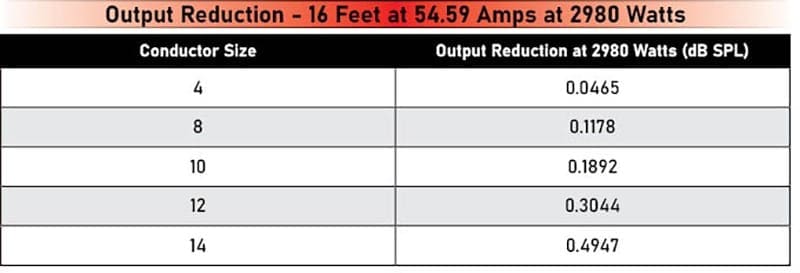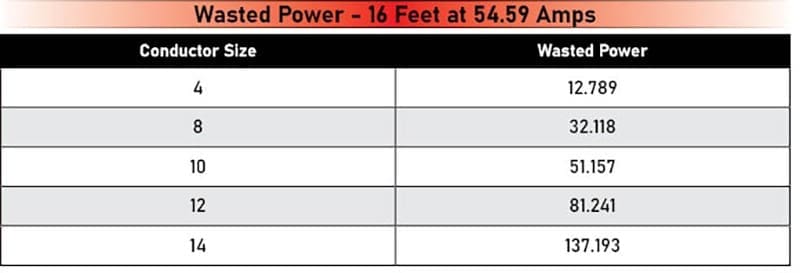We recently saw a question on one of the Rockford Fosgate Facebook groups about what gauge of subwoofer wire is appropriate for a particular installation. Thankfully, the person asking the question knew to include the model of the amp and subwoofers he was using. Further, he noted the final load impedance. Best of all, he said he needed three feet of wire. Given all that, we can do some simple calculations to determine what size wire is adequate.
Why Subwoofer Wire Size Matters
The size of wiring you use between the amplifier and a speaker isn’t quite as important as the wire that feeds power to the amp. If you starve an amplifier for voltage, it will reach the point where it clips earlier. If the wiring to your subwoofers isn’t large enough, energy is wasted in the wire, and the subwoofers don’t play as loudly. You don’t want to waste 100 watts of power as heat in the wiring when that could be used to drive your speakers. If it all seems a little complicated, don’t fret. We’ll go through everything step-by-step.
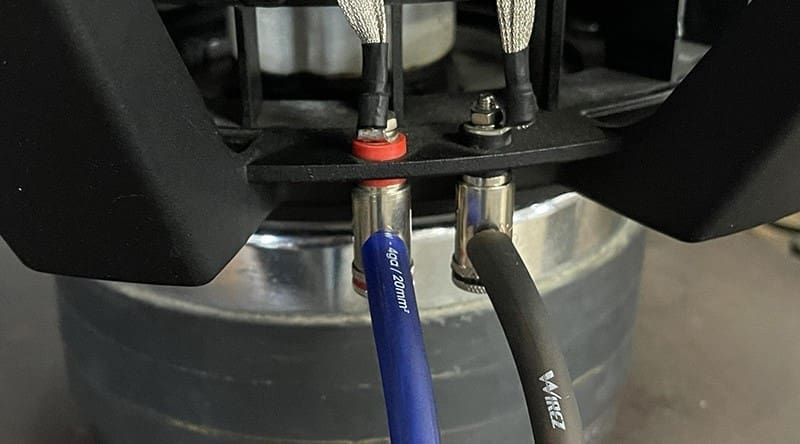
Amplifier Power
The question concerns the Rockford Fosgate R2-1200×1. This amp is rated to produce 1200 watts of power to a 1-ohm load. When supplied with 14.4 volts, we saw 1265 watts in our Test Drive Review when measured at 1% THD+N. Given the capabilities of the electrical systems in most vehicles, we’ll call this 1200 watts.
We need to calculate the amount of current flowing in the wire before we can start analyzing voltage drops. Twelve hundred watts into a one-ohm load would result in 34.64 amps of current flowing at any frequency where the impedance is indeed one ohm. The equation to calculate current is to take the square root of power divided by resistance.
Wire Resistance Calculations
We need three feet of wire for the positive and negative runs from the amp to the enclosure. If the wiring inside the enclosure is efficient, we’ll need at least another few feet of wire to connect to all the voice coils. To simplify this, we’ll say the total wire length is eight feet. This will give us adequate answers to choose the best conductor size.
We’ll run the math on four different wire sizes. The amp can accept 8-AWG wire on the outputs without any issue, so that will be the largest wire we’ll make calculations on. We can do the math on 10, 12, and 14-AWG conductors from there. We’ll assume all the wiring meets the ANSI/CTA-2015 standard for strands and size and doesn’t contain aluminum. If you want that aluminum stuff, we can’t help.
Voltage Drop Calculations
With 34.64 amps of current flowing in eight feet of 8-AWG wire, we calculate a voltage drop of 0.1876 volts. Reducing the wire size to 10-AWG increases the drop to 0.2973 volts. The 12-AWG wire has a voltage drop of 0.4722 volts. Finally, the 14-AWG wire has a voltage drop across the conductor of 0.7509 volts. Thankfully, none of those voltage drops are significant. To perform the calculations, we use the nominal resistance per meter of full AWG-spec conductors as found in the CTA-2015 standard. The formula used to calculate the voltage drop is current times resistance.
If we calculate the power wasted in the different-sized cables, we can easily calculate the reduction in output. The 8-AWG will consume 6.466 watts of power. The 10-AWG consumes 10.299 watts. The 12-AWG consumes 16.356 watts. Finally, the 14-AWG consumes 16.011 watts. We don’t have any significant heating issues when we divide that thermal energy over the eight-foot run for any of these wire sizes.
The formula used to calculate power wasted in the wire is voltage times current.
Output Level Calculations
If we convert the 1200 watts into a decibel-watt level, we get 30.79181 dB W. The formula to do that is ten times the log of power, which is 1200 in this case. We can then do the same calculations based on how much power the subwoofers would see when subtracting the numbers in the above paragraph. Cutting to the chase, we see an output loss of 0.0234 dB with the 8-AWG wire. The 10-AWG results in an output decrease of 0.0374 dB. The 12-AWG wire reduces output by 0.0596 dB. Finally, the 14-AWG would reduce the output by 0.0952 dB. You’d never hear any of these losses. With that said, we’d still run the 12-AWG wire.
Multiple Conductors Reduce Losses
Rockford Fosgate amplifiers are well-known for having multiple positive and negative terminals. As such, your installer can quickly run a set of wires to each subwoofer. This cuts down the losses even more. Six hundred watts of power into a 2-ohm load requires only 17.32 amps of current. If the installer wired the voice coils of each subwoofer in parallel, then ran a wire from each subwoofer to the amp, the losses of the different-sized wiring would be 0.0117, 0.0187, 0.0297, and 0.0473 dB with eight through 14-AWG wire sizes. Running a little extra wire sure can’t hurt.
Huge Power Creates Heat
Now, let’s look at a more significant example. Say you have a Rockford Fosgate Power T2500.1bdCP amplifier connected to a single T3S1-19 Superwoofer. For argument’s sake, the wiring needs to run eight feet from the amp to the sub, equal to 16 feet of conductor. You aren’t going to build this system without pushing the amp to its limit, so we’ll use the amp’s 2980-watt maximum dynamic power specification when driving a one-ohm load. Into a one-ohm load, 2980 watts means there are 54.59 amps of current flowing in the wire.
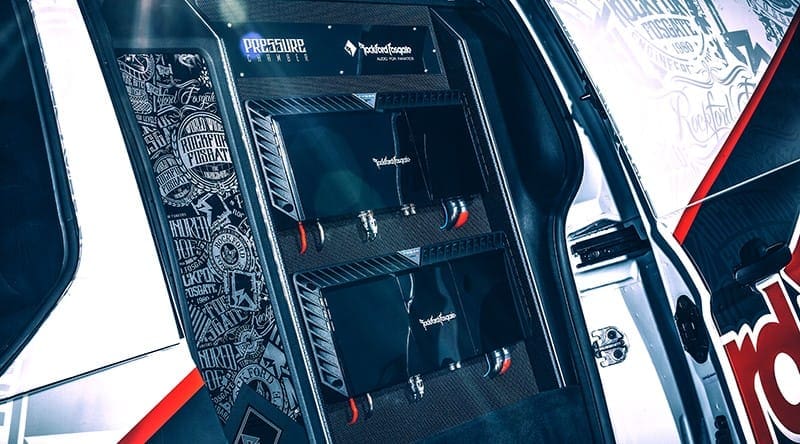
This is where understanding how speakers and decibel scales matter. First, we are dealing with almost 3000 watts of power. Even if we waste 100 watts of power as heat, the difference in output isn’t significant. If we only had 500 watts and wasted 100, that would be a problem. Working backward from small to large conductors, we see drops in the output: 0.4947 dB with 14-AWG wire. That drops to 0.3044 dB with 12-AWG, 0.1892 dB with 10-AWG, and 0.1178 dB with 8-AWG. Since we have the spreadsheet open, 4-AWG wiring has a minute 0.0465 dB drop. Based on these calculations, 12-AWG seems like a reasonable minimum, though 8-AWG would be a better choice.
That said, we need to go back to calculating how much power we are losing as heat. The 14-AWG wiring would dissipate 129.2 watts of heat energy. Think about how hot a 100-watt incandescent light bulb gets. This isn’t going to work. A run of 12-AWG wire wastes 81.241 watts, 10-AWG wastes 51.157 watts, 8-AWG wastes 32.118 watts, and 16 feet of 4-AWG wire passing almost 3000 watts into a one-ohm load wastes only 12.789 watts of energy. Based on these numbers, we’d suggest that 8-AWG cable is the minimum for this application.
Answer the Question, Please.
So, what size wire does this person need for his pair of subwoofers? The runs are so short that it almost doesn’t matter. A pair of 14-AWG wires, one run to each subwoofer, would be fine. We’d wire it up with a pair of 12-AWG wires just to be extra safe.
If you get crazy about power levels and are above a few thousand watts into a low impedance, then 8-AWG conductors are a minimum. Four-AWG is likely a better choice above 3000 watts into a one-ohm load. Lower impedances require even larger wires.
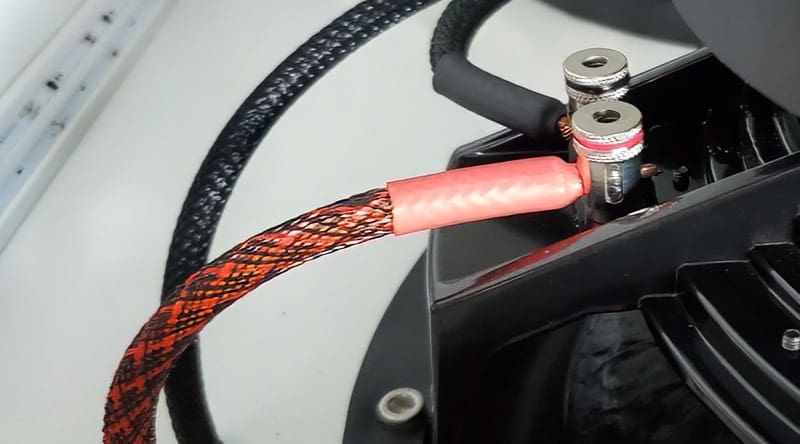
Ultimately, there are two factors to consider – power losses and heat. For the 1200-watt amp, there isn’t enough power involved, nor is the impedance low enough for the size of the wire to be a massive issue. When you get into extremely powerful amplifiers, you don’t want more than five watts of power per foot of cable. The less heat, the better.
Visit a local specialty mobile enhancement retailer to determine what wire you need for your installation. They should be happy to help!




